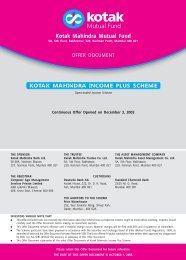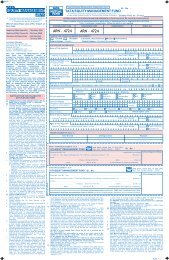OFFER DOCUMENT
Balanced Offer Document - Appuonline.com
Balanced Offer Document - Appuonline.com
- No tags were found...
You also want an ePaper? Increase the reach of your titles
YUMPU automatically turns print PDFs into web optimized ePapers that Google loves.
Prudential ICICI Mutual Fund<br />
Future price = Closing spot price = 4950<br />
Profits for the Fund = (4950-4920)*10000 = Rs 300,000<br />
Please note that the above example is given for illustration purposes only.<br />
The net impact for the Fund will be in terms of the difference between the closing price of the index and cost price<br />
(ignoring margins for the sake of simplicity). Thus, it is clear from the example that the profit or loss for the Fund will be<br />
the difference of the closing price (which can be higher or lower than the purchase price) and the purchase price. The<br />
risks associated with index futures are similar to the one with equity investments. Additional risks could be on account of<br />
illiquidity and hence mispricing of the future at the time of purchase.<br />
Risks attached with the use of derivatives:<br />
As and when the schemes trade in the derivatives market there are risk factors and issues concerning the use of derivatives<br />
that investors should understand. Derivative products are specialized instruments that require investment techniques<br />
and risk analyses different from those associated with stocks and bonds. The use of a derivative requires an understanding<br />
not only of the underlying instrument but of the derivative itself. Derivatives require the maintenance of adequate controls<br />
to monitor the transactions entered into, the ability to assess the risk that a derivative adds to the portfolio and the<br />
ability to forecast price or interest rate movements correctly. There is the possibility that a loss may be sustained by the<br />
portfolio as a result of the failure of another party (usually referred to as the “counter party”) to comply with the terms<br />
of the derivatives contract. Other risks in using derivatives include the risk of mis pricing or improper valuation of derivatives<br />
and the inability of derivatives to correlate perfectly with underlying assets, rates and indices.<br />
Thus, derivatives are highly leveraged instruments. Even a small price movement in the underlying security could have a<br />
large impact on their value. Also, the market for derivative instruments is nascent in India.<br />
Valuation of Derivative Products :<br />
a) The traded derivatives shall be valued at market price in conformity with the stipulations of sub clauses (i) to (v) of<br />
clause 1 of the Eighth Schedule to the Securities and Exchange Board of India (Mutual Funds) Regulations, 1996, as<br />
amended from time to time.<br />
b) The valuation of untraded derivatives shall be done in accordance with the valuation method for untraded investments<br />
prescribed in sub clauses (i) and (ii) of clause 2 of the Eighth Schedule to the Securities and Exchange Board of India<br />
(Mutual Funds) Regulations, 1996 as amended from time to time.<br />
12) Subject to the Regulations and the applicable guidelines, the Scheme and the Plans thereunder may, if the Trustee permits,<br />
engage in stock lending.<br />
Advantages and Risks attached with investments in ADRs/GDRs:<br />
It is AMCs belief that the investment in ADRs/GDRs/overseas securities offer new investment and portfolio diversification<br />
opportunities into multi-market and multi-currency products. However, such investments also entail additional risks. Such<br />
investment opportunities may be pursued by the AMC provided they are considered appropriate in terms of the overall investment<br />
objectives of the schemes. Since the Schemes would invest only partially in ADRs/GDRs/overseas securities, there may not be<br />
readily available and widely accepted benchmarks to measure performance of the Schemes. To manage risks associated with<br />
foreign currency and interest rate exposure, the Fund may use derivatives for efficient portfolio management including hedging<br />
and in accordance with conditions as may be stipulated by SEBI/RBI from time to time.<br />
To the extent that the assets of the Schemes will be invested in securities denominated in foreign currencies, the Indian Rupee<br />
equivalent of the net assets, distributions and income may be adversely affected by the changes in the value of certain foreign<br />
currencies relative to the Indian Rupee. The repatriation of capital also may be hampered by changes in regulations concerning<br />
exchange controls or political circumstances as well as the application to it of the other restrictions on investment.<br />
Offshore investments will be made subject to any/all approvals, conditions thereof as may be stipulated by SEBI/RBI and provided<br />
such investments do not result in expenses to the Fund in excess of the ceiling on expenses prescribed by and consistent with<br />
costs and expenses attendant to international investing. The Fund may, where necessary, appoint other intermediaries of repute<br />
as advisors, custodian/sub-custodians etc. for managing and administering such investments. The appointment of such<br />
intermediareis shall be in accordance with the applicable requirements of SEBI and within the permissible ceilings of expenses.<br />
The fees and expenses would illustratively include, besides the investment management fees, custody fees and costs, fees of<br />
appointed advisors and sub-managers, transaction costs, and overseas regulatory costs.<br />
Risks associated with stock lending : The risks in lending portfolio securities, as with other extensions of credit, consist of the<br />
failure of another party, in this case the Approved Intermediary, to comply with the terms of agreement entered into between the<br />
lender of securities i.e. the Scheme and the approved intermediary. Such failure to comply can result in the possible loss of rights<br />
in the collateral put up by the borrower of the securities, the inability of the Approved Intermediary to return the securities<br />
deposited by the lender and the possible loss of any corporate benefits accruing to the lender from the securities deposited with<br />
the Approved Intermediary.<br />
32









